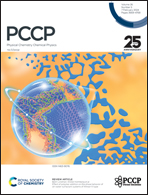Elucidating the mechanism and origin of stereoselectivity in the activation/transformation of an acetic ester catalyzed by an N-heterocyclic carbene†
Abstract
The activation of an ester by N-heterocyclic carbene (NHC) organocatalysis is an efficient and important approach for generating an NHC-bound enolate intermediate, an important active intermediate in the transformation of carbonyl compounds. Herein, we perform a theoretical study on the NHC-catalyzed activation and transformation reaction of an acetic ester in which the NHC-bound enolate intermediate is a key intermediate. Multiple activation and transformation pathways are proposed and analyzed to identify an energetically favorable pathway. The use of different substrates for the reaction is considered. When a chalcone substrate is used, [4+2] cycloaddition between the enolate intermediate and the chalcone is identified to be both the rate- and stereoselectivity-determining step for the reaction, with the R-configured product being generated as the major isomer. Noncovalent interaction (NCI) and atoms-in-molecules (AIM) analyses are performed to identify the origin of the stereoselectivity of the reaction, and a local reactivity analysis is conducted to explore substrate and catalyst effects on the reaction.



 Please wait while we load your content...
Please wait while we load your content...